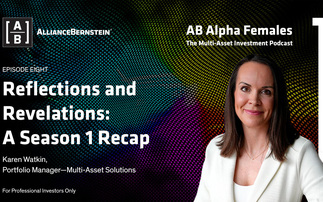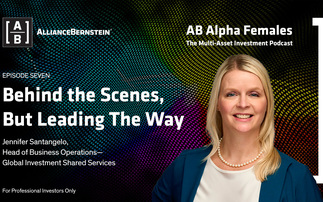Changes were made earlier this year to Prudential's multi-asset range. Paul Fidell, Head of Business Development, Investments at Prudential, explains why the changes have been made and how the team are approaching asset allocation within the multi- asset portfolios given today's challenging economic climate.
Asset allocation approach within the range of Prudential's multi-asset portfolios
We believe that the key to delivering better risk- adjusted returns for investors comes down to having complementary strategies for both strategic and tactical asset allocation. Teams across M&GPrudential work collaboratively to research capital markets with different teams having different areas of expertise across both strategic and tactical asset allocation, portfolio management and implementation. We think this is vital. These elements provide quite different market insights, both of which can provide information for the portfolios in unique ways.
Our long-term investment strategy team analyse a huge range of strategic factors. Overall we position the portfolios to benefit from medium to longer term capital market views. This means that the team will consider things like secular views and regime change alongside taking broad views on the business and economic cycle. In general, the outlook here is on the period of three to five years plus.
Working alongside them we have a separate team focusing on shorter term behavioural market timing. They will work on anything from a one month to an 18 month outlook.
It's this approach which helps to inform and underpin our portfolio decisions. It applies to all our multi-asset portfolios and is basically the DNA or commonality between them.
Our multi-asset risk managed range, PruFolio, consists of three different investment styles - passive, active and smoothed. Within those are five different strategies to match various risk profiles. This creates a matrix of 15 different funds but essentially it's one philosophy, three different investment styles with five risk strategies within that. As advisers would expect, within the higher risk portfolios you'd have correspondingly higher exposure to risk assets such as equities.
Positioning the portfolios for 2019 and beyond
Overall, we are still focused on the fundamentals which we still think look pretty good. However, we've been seeing some extreme bouts of volatility recently which we try to work through and use such periods to look for opportunities to buy or sell on what we see as attractive terms.
Generally we're aiming to position the portfolios for the medium to longer term and to cope with a number of different economic scenarios. This may sound like we are aiming for the average. We're not. We're aiming for the best possible return for the amount of risk that our underlying clients are comfortable taking. And to create as much of an all-weather approach as we can.
Economic "headwinds" that might impact upon performance
As we started 2019 there were quite a few of these. The slower growth outlook looks likely to be around during 2019 and for some time to come. As the global economy adjusts to life coming off quantitative easing (QE), deals with worries about Brexit, concerns about Italy, interest rate hikes, trade wars etc. This is creating a degree of uncertainty which markets don't like. This is being borne out in market movements of late. Outside of equities, credit indicators are not looking too extreme - not cheap, but not expensive either. The bottom line is that short term volatility is likely to be greater as investors and markets deal with this uncertainty on a whole range of different fronts.
Diversification in the current investment climate
In our view diversification has always been important. It is more of a challenge to achieve. No longer is it possible to rely on major building blocks of equities, bonds and cash. Within our portfolios we look to be as well diversified as we can without overdoing it and where possible - and appropriate - we will use asset classes outside the major ones. This includes alternative investments, hedge funds, private equity, infrastructure etc. In the credit market we'll consider private high yield, private placement, bridging finance and new geographies. This all requires the team having the requisite knowledge, skills and experience. All of these exist within the Prudential Group.
What's the difference between the PruFolio Risk Managed Passive, Active and Smoothed ranges?
Our multi-asset fund range has been in place for some time, but in January 2019, we made some fundamental changes as well as some name changes. The main thing is that the whole fund range now shares the same approach to strategic and tactical asset allocation, as I explained earlier.
When it comes to the differences, firstly, there are changes to the way that we deliver that asset allocation exposure.
The passive range is now at least 70% invested in passive vehicles. Here we're predominantly using funds from iShares by Blackrock. Within the range, up to 30% can be invested in actively managed funds.
In the active range, we're using actively managed funds predominantly available from within the Prudential group - from M&G and Eastspring Investments (our Asian asset management business). The remainder is invested in a selection of funds from external investment managers. Mainly these are Royal London and Legal and General and have been selected for further diversification benefits.
These sit appropriately alongside funds from M&G to provide greater diversification. The most significant change here is that we used to involve Morningstar as fund advisers to help with selection of external managers for use in the portfolios. We are now using a largely internal, actively- managed approach.
Our smooth range uses the established PruFund smoothing approach. It combines this with full active management of the underlying range of assets, the majority of which is managed in-house.
M&GPrudential Investment Process
Our team continues to do all the same things they've done for years, but it is now a wider team known as the M&GPrudential Treasury and Investment Office (T&IO). It has significant scale, expertise and knowledge and oversees the management of around £170 billion of Prudential's investments. They do all the thinking around the strategic and tactical asset allocation, here working in conjunction with the M&G Multi Asset team on TAA, and also do manager oversight, risk and all the modelling for the longer term views. This brings together all the expertise we have. After that we use the processes to deliver the returns in the three ranges.
Why consider Prudential's PruFolio Risk Managed Range?
Our particular strengths are the Prudential brand which clients are very likely to be familiar with, our excellent long term reputation as investment managers, the past performance of our multi-asset approach and also the simplicity of the fund range. This gives a broad variety of different styles which we believe will help advisers to match them with their different clients' needs and their variety of risk appetites.
Running multi-asset funds is what Prudential has specialised in for over 20 years. If you go back to the With-Profits fund, which could be seen as the grandmother of all multi-asset funds - you can trace that back for many decades and see how this has performed throughout a multitude of different economic and market conditions. More often than not, we have delivered returns which exceed expectations and done so without taking on significantly greater risk. This approach is now available to advisers in a wide variety of funds and styles - and risk profiles - so it gives advisers greater choice.
Costs of the funds
We've reduced the cost of all of the collective funds to be extremely competitive. The passive range has an ongoing cost to the fund Ongoing Charge Fees (OCF) of around 26 basis points as an average. For the active funds, this increases to around 56 or 57 basis points as an OCF. Of course, selecting funds is not just about price, it's about having all the benefits of the M&GPrudential Treasury and Investment Office including the skills and thinking of the experts within it around strategic and tactical asset allocation.
Risk management
The range was previously defined in terms of risk by an equity holding range which could be held within each fund. For example, 0-30%, 10-40%, 20-55%, 40-80% and 60-100%. Rather than simply tying ourselves to using equities, and beyond that in quite narrow bands, we've changed the objective to using a volatility ceiling. This gives greater flexibility for the teams involved in portfolio construction to align more closely to their risk parameters. In addition, it fits in more closely with the FCA's thinking about how risk managed funds should be described for investors. There is great pressure of transparency for managers so that investors have a better understanding of how those funds operate. In this light, having a volatility ceiling makes a lot more sense. These funds are essentially run relative to each other. We don't have a particular benchmark, we're not trying to track sector averages or anything else.
They are run and named in a relative way - a step up in the amount of risk being taken - which should, if things work out as we expect, lead to higher returns for investors - as well as higher levels of volatility of course. So portfolios with the number 5 in their name will have the highest risk exposure, whilst those with 1 will have the lowest.
Overall, we're confident that the changes made to our range will help advisers to provide more effective multi-asset solutions for their clients, so that they can spend more time building and developing client relationships and demonstrating the value of the financial planning service they can provide.
Learn more about the PruFolio Risk Managed Range or speak with a Prudential Account Manager.











